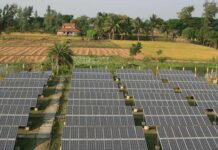Introduction:
Building a carbon-neutral world relies on the widespread adoption of green technologies and sustainable solutions. With the rising environmental concerns and businesses investing in innovations to decrease their carbon footprints, economic growth has accelerated. The green technology & sustainability market is not just lowering greenhouse gas emissions; it is also generating new employment opportunities, enhancing energy security, and fostering unparalleled growth in developing industries. Fueling the growth, ongoing advancements in renewable energy and smart infrastructure present efficient management of resources and long-term sustainability to the market.
This article highlights the cutting-edge trends and innovations that are transforming industries and powering a carbon-neutral future.
Integration of renewable energy and smart grids
The first step of decarbonization is shifting to renewable energy like solar, wind, geothermal, and small modular nuclear reactors (SMRs). The latest SMR technology is gaining traction due to its stability, low-carbon alternatives for data centers, and remote microgrids. On the other hand, smart grids, driven by the Internet of Things and AI technologies, compensate the distributed energy sources, streamline usage, reduce losses, and integrate energy storage. This balance brings a resilient, effective, and low-emission power infrastructure.
Advanced cooling and heating solutions
Innovations in cooling and heating technologies aid in decarbonizing buildings and industrial processes. Advanced processes such as immersion cooling, indirect evaporative systems, and waste heat purposing have played a pivotal role in shaping data centers and now are being adapted to wider applications. For instance, immersion-based thermal management decreases energy usage by 50%, as well as water heat reuse and district heating transform excess heat into useful warmth for homes or commercial spaces. These technologies contribute significantly to lowering carbon emissions by enhancing overall energy efficiency. Moreover, incorporating smart controls and real-time tracking enhances system efficiency, making these solutions versatile and suitable for a variety of industries and environments.
Circular economy and material innovation
The best way of reducing waste is to repurpose it. The green tech market is adopting biodegradable electronics, low-carbon concrete, and recyclable materials. These advancements lower lifecycle emissions and promote circular economy approaches, where items are designed for longevity and parts are reimagined to aid the industrial process, reducing landfill effects. Businesses are also adopting design for disassembly, repairing, repurposing, or recycling of products once they reach the end of their life. Modular smartphones, reusable packaging, and clothing crafted from single-fiber threads are some of the real-world examples.
Energy efficiency and automation
Energy efficiency is the most vital aspect of attaining sustainability. Many initiatives, such as the green building certifications, emphasize the envelope design, LED lighting, efficient HVAC, and AI-driven control systems. In data centers, reinforcement learning (RL) algorithms are making significant progress by independently optimizing cooling operations and cutting energy consumption by more than 20%. These tools evolve gradually, continuously refining operational metrics to improve efficiency and sustainability.
Electric and green mobility infrastructure
The automobile sector represents almost 25% of worldwide greenhouse gas emissions, positioning it as an essential driving force for carbon neutrality. The surge of electric vehicles, from personal vehicles, public transport, and aviation, is rapidly transforming the overall energy landscape. The main character governing this shift is innovation in energy storage, especially through advanced lithium-ion batteries, solid-state batteries, and scalable grid storage options. The growth of green mobility infrastructure provides a fundamental aspect for sustainable urban planning, providing not only decreased emissions but also quieter, cleaner, and more enjoyable urban environments.
Collaborations across different sectors and open innovation
To achieve a carbon-neutral world, it is important to work together, gathering insights and innovating with the best minds and technologies of the world. A notable example can be seen in the collaborations between renewable energy companies and data center cooling technology suppliers. Historically energy-heavy, data centers are now leading in sustainability by adopting renewable-powered cooling technologies, including solar-assisted liquid cooling and AI-enhanced HVAC solutions.
Government Support, Financing, and Market Growth
For pivotal changes to take place in the already existing climate policies, strong support from governments and investors is crucial. Numerous countries are currently establishing new regulations and providing incentives to assist businesses in becoming more environmentally sustainable. This encompasses actions such as imposing fees on polluters, offering tax incentives to eco-friendly companies, and establishing targets for clean energy utilization. These regulations simplify and increase the urgency for businesses to genuinely engage in climate initiatives.
Conclusion:
The carbon-neutral voyage continues with the ongoing innovations across multiple sectors that include renewable energy, advanced materials, intelligent automation, and robust infrastructure. With the growing prevalence of clean energy sources and the advancement of technologies like efficient cooling systems and circular economy materials, organizations and governments worldwide are progressively embracing sustainable practices. These improvements not only lower greenhouse gas emissions but also boost operational efficiency and preservation of resources. To sum up, these factors collectively are transforming the green technology and sustainability market, fueling economic expansion and environmental responsibility.






![SMART ENERGY WEEK [September] 2025 to Lead Global Renewable Energy Advancements SMART ENERGY WEEK](https://timestech.in/wp-content/uploads/2025/07/Untitled-design-2025-07-31T112230.406-218x150.jpg)










